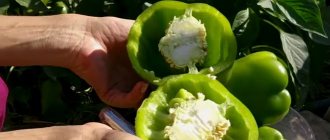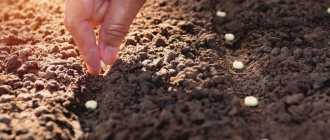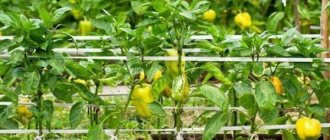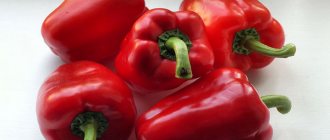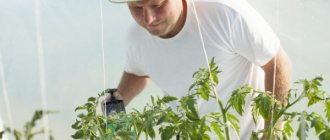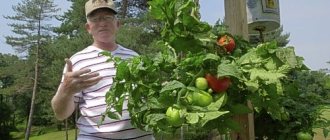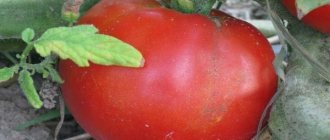Pepper Python characteristics and description of the variety
We have to thank the company of proprietary seeds “Gavrish” for the appearance of this strange and interesting hybrid on the modern market.
The characteristic features of the variety include:
- Early ripeness - no more than 125 days pass from the formation of the first shoots to the beginning of fruiting;
- This is a sweet pepper, despite the characteristic shape that is often found in hot peppers;
- The height of the bush can reach 140 cm when Python is grown in glass and film greenhouses;
- The shape of the fruit is trunk-shaped and can reach 27 cm in length;
- The average weight of the fruit is 60 g with a wall thickness of 3 mm;
- The color of the fruit changes from green to red after reaching full maturity.
Before planting, the seeds are usually germinated into seedlings, sown at the end of February and transferred to open soil by the end of May. Harvesting can begin as early as July.
Description and characteristics of the variety
Sweet Python pepper was created by specialists. It is recommended to grow it in greenhouses of any type - glass and film. In the south, cultivation in open ground is allowed.
Some gardeners plant the plant on balconies, like sharp varieties, but the bush is tall and requires staking and a large amount of soil. If it is not possible to ensure this, it is better not to plant on the balcony.
The bush is tall, reaches 1-1.4 m, semi-spreading, moderately leafy. The average ripening period is 115-125 days after germination. The fruits are elongated, trunk-shaped, narrow and thin, and can curl at the ends. The length of the peppers is about 27-30 cm, and the weight is 60 g. At the ripe stage, the fruit is red, but is suitable for harvesting at technical ripeness with a dark green color. Thin walls about 3 mm thick. The taste is sweet and pleasant.
The fruits can be used for fresh consumption and cooking (except for stuffing), pickling, and preservation. They are eaten fully ripe and at the stage of technical maturity. There is no need to remove seeds during this period.
Agricultural cultivation techniques, care recommendations
It is recommended to start sowing seedlings several months before planting seedlings in open ground, in February or March.
For sowing, it is necessary to prepare in advance a fertile mixture of garden soil, ash, humus, peat and a drainage layer of sand.
After this you need:
- Disinfect the mixture by calcining it in an oven or simply pour it with a hot solution of potassium permanganate;
- Before sowing, it is also recommended to disinfect the seeds by filling them with a one percent solution of potassium permanganate, and then treating them with a mixture of a growth stimulator;
- Since pepper roots are very thin and fragile, they are easily damaged during the transplanting process. To avoid possible damage, it is recommended to immediately sow seedlings in peat tablets or separate glasses;
- It is recommended to sow seeds to a depth of no more than a centimeter, then cover the containers with seeds in a warm place, covering them with film, creating greenhouse conditions;
- After the formation of the first shoots, the containers need to be moved to the windowsill. It is important to provide sufficient lighting for 12-15 hours. If there is not enough daylight, use special lamps;
- At the two-leaf stage, transplant into separate containers;
- Planting in open soil is carried out at the rate of three plants per square meter;
- It is recommended to water the planted seedlings daily with warm, settled water. It is better to water in the morning or evening, avoiding periods of midday heat;
- Before the seedlings take root, they only need to be watered, after which you should start loosening the soil without fear of damaging the root;
- It is recommended to fertilize seedlings three to four times a season with complex mineral fertilizers containing nitrogen, potassium and phosphorus.
In addition to general care, you need to deal with the formation of the bush. All shoots up to the first fork should be cut off.
Let's watch a video about growing sweet salad peppers:
Agrotechnics of cultivation, planting and care
Sowing pepper seeds for seedlings is carried out 60-70 days before the intended planting of plants in a permanent place. The optimal temperature for seed germination is 26-28°C.
When true leaves appear on the plants, they are transplanted into separate cups with a capacity of 0.3-0.5 liters. Pepper does not like transplanting, so do not be surprised if after you have transplanted the seedlings into separate containers, they stop growing for a while. You can “smooth out” the stressful state a little by spraying the plants with Epin.
When to plant pepper seedlings in the ground
After the threat of return frosts has passed, the seedlings can be planted in a permanent location. Some people plant in open ground in May, while others only plant under covering material or under film; it all depends on the climatic conditions of your region.
When planting pepper seedlings in the ground for 1 sq. It is recommended to place 4-6 plants per meter of land, no more. Peppers are planted in the ground without being buried, but in exactly the same way as they grew in cups. Pepper plants, unlike tomatoes, very rarely produce lateral roots, so there is no point in deepening them.
Sweet peppers respond well to watering and fertilizing with complex mineral fertilizers. During the summer, 2-3 feedings are usually done.
Advantages and disadvantages
In addition to its interesting shape, this hybrid is distinguished by a number of positive properties.
These include:
- It is resistant to attacks from most pepper diseases;
- Resistant to temperature fluctuations;
- With a temporary lack of moisture in the soil, the amount of harvest does not decrease;
- It has a relatively high yield of up to a kilogram per bush;
- Known for its pronounced aroma, although the taste is moderate;
- When grown on glazed balconies, the fruiting period can be extended.
Despite all the advantages of the hybrid, some users note excessively thin walls. In addition, due to its shape, Python is often confused with hot peppers.
Growing seedlings
This variety of pepper is grown only by seedlings.
First of all, you need to prepare the soil mixture. The soil should be fertile, light and structured. To prepare the soil mixture, take humus, black soil, peat, sand and ash.
Sow seeds in shallow containers with holes to drain excess moisture. Buy seeds only from trusted suppliers, in special stores.
Before sowing, check germination and disinfect the seed. You can treat the grains with a solution of a growth stimulator and a fungicide.
The seeds should not be planted too deeply; just sprinkle them with a thin layer of soil.
After sowing the seeds, water the soil and cover with film to create a greenhouse effect.
In the first few days, the presence of sunlight is not necessary; heat and moisture will be enough. After germination, transfer the container with seedlings to the windowsill. The seedlings will need large amounts of solar energy.
When growing seedlings at the end of February, you will definitely need to illuminate the seedlings with special lamps, since the daylight hours during this period of the year are not yet long enough.
DO NOT sow seeds too thickly; when sowings are thickened, seedlings stretch out and the plants lack sunlight and nutrients. Overgrown, elongated seedlings do not tolerate transplantation well, take a long time to take root, and are sick for a long time. Such plants will never produce a high yield.
Seedlings at the age of 2-3 weeks are fed with nitrogen fertilizers, which stimulate the growth of the vegetative mass.
Remember that pepper is a heat-loving plant that does not tolerate drafts and temperatures dropping to 8-9 degrees. After short-term exposure to low positive temperatures, bell pepper freezes and stops growing for a very long time.
At the stage of 3-4 leaves, the seedlings must be picked and then transplanted into separate cups or pots.
Python pepper photos and reviews from those who grew them
In general, users who fell for the non-standard form were satisfied. So those who have grown note the convenience of growing Python on the balcony and in open ground.
The rich aroma is also not ignored, thanks to which the fruits perfectly complement salads.
In general, the reviews are positive due to the extraordinary shape, which is not typical for sweet varieties.
Gardeners express sincere surprise, because when buying seeds from a photo, they did not expect that the result would correspond to the picture.
Python pepper: what to do with it, what dishes you can cook
Due to its strong spicy odor, Python is often used as a seasoning for dishes in raw and dried form, after grinding it. In addition, you can consume the fruits fresh, cutting them into salads, complementing other vegetables of the season.
In addition to seasoning and salad dressing, this spicy pepper is used for pickling and canning.
Basically, the fruit is used as an additional ingredient, and not as an independent dish.
Python pepper has a non-standard shape for a sweet appearance and a pronounced aroma. Suitable for growing on balconies, in greenhouses and in open ground.
Benefits of sweet pepper "Python"
The Python pepper has really grown the way it should, judging by the promises of the seed company. True, for me he was shorter. In the garden bed in the greenhouse and in voluminous flower pots standing on the glassed-in loggia, there were spectacular “trees” strewn with long thin fruits. Sometimes straight, sometimes with donut-curled tails. I would include the viability of the hybrid as an obvious advantage. Two pots with “Python”, which I kept near the house all summer and early autumn, withstood the night cold snap (without frosts). Later they continued to bear fruit on the glassed-in loggia. Despite the fact that there were no pollinators there except flies, rare night moths and a bumblebee immediately released into the wild.
The fruits are tasty, having almost the same aroma as other sweet peppers. There is absolutely no bitterness in them.
The Python hybrid is also suitable for growing at home. You can safely keep it in the “garden on the windowsill.” I placed one pot with the most compact, low-growing pepper in the kitchen. There “Python” feels excellent: it blooms and bears fruit profusely.
This summer we had interruptions in watering. This obvious violation of agricultural technology did not affect the productivity of the hybrid, although the peppers often stood with drooping leaves.
I was not involved in the formation of the plant. At the same time, slender “trees” grew, the maximum height of which was no higher than 90 cm. Even those “Pythons” that grew on the glassed-in loggia had no diseases or pests.
Among the obvious advantages, I would note the high preservation of fruits. Several beautiful bright scarlet peppers have been staying fresh for several weeks on a southwest-facing kitchen windowsill. They look very impressive among indoor plants.



